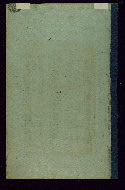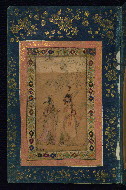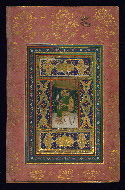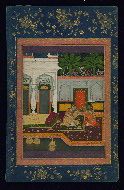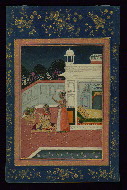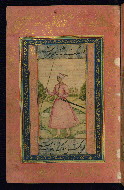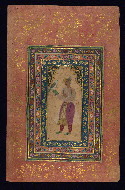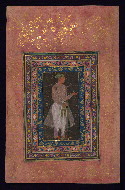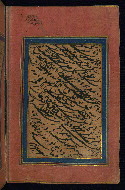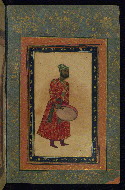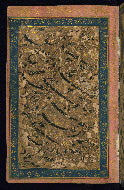Home > Digitized Walters Manuscripts
This document is a tranformation of a TEI P5 XML manuscript description incorporating images. If you have trouble reading special or non-Latin characters on this page, please make sure you have appropriate Unicode fonts installed and an up-to-date web browser.
Walters Ms. W.668, Album of Persian and Indian calligraphy and paintings
Browse images (Browse images in a new window) | TEI in XML format
W.668
Album of Persian and Indian calligraphy and paintings
Vernacular: مرقع
This is an album (muraqqaʿ) of Persian and Indian calligraphy and paintings, most probably compiled in the thirteenth century AH / nineteenth CE. The album contains thirty-four illustrations, three of which are attributed to the Mughal painter Abū al-Ḥasan (Nādir al-al-Zamān), two to Manūhar, and one each to Dawlat and Ṣādiqī. There are several portraits of rulers and courtiers, as well as scenes from historical manuscripts, such as Bāburnāmah and Gulistān by Saʿdī. This album is also significant for the number of works by the artist Shayk Abbāsī, who worked in the eleventh century AH / seventeenth CE. The signed calligraphic pieces bear the names of ʿImād al-Ḥasanī (d. 1024 AH / 1615 CE), ʿAlī Riz̤ā-ʾi ʿAbbāsī, Mīr ʿAlī, and ʿAbd al-Rashīd al-Daylamī (d. 1081 AH / 1670-1 CE). The album was initially in an accordion format and was later made into a codex. The lacquer binding with central ovals and pendants decorated with flowers dates to the thirteenth century AH / nineteenth CE.
Late 10th century AH / 16th CE -- 13th century AH / 19th CE
Iran or India
As-written name: Abū al-Ḥasan Nādir al-al-Zamān
Name, in vernacular: ابو الحسن نادر الزمان
As-written name: Manūhar
Name, in vernacular: منوهر
As-written name: Ṣādiqī
Name, in vernacular: صادقى
As-written name: Dawlat
Name, in vernacular: دولت
As-written name: ʿImād al-Ḥasanī
Name, in vernacular: عماد الحسنى
Known as: Mīr ʿImād
As-written name: ʿAlī Riz̤ā-ʾi ʿAbbāsī
Name, in vernacular: على رضاء عباسى
As-written name: Mīr ʿAlī
Name, in vernacular: مير على
As-written name: ʿAbd al-Rashīd al-Daylamī
Name, in vernacular: عبد الرشيد الديلمى
Album
Historical
Literary -- Poetry
The primary language in this manuscript is Persian.
Paper
Mounted on pasteboard
Foliation: 82
A number of leaves housed separately
Comments: Made into a codex from an accordion book
19.0 cm wide by 29.5 cm high
- Layout differs from folio to folio
- Title: Muraqqaʿ
- Scribes: ʿImād al-Ḥasanī; Mīr ʿAlī; ʿAbd al-Rashīd al-Daylamī; ʿAlī Riz̤ā-ʾi ʿAbbāsī
- Artists: Manūhar; Ṣādiqī; Dawlat; Abū al-Ḥasan Nādir al-al-Zamān
- Hand note: Written in calligraphic nastaʿlīq script with some folios in shikastah script; signed calligraphy by ʿImād al-Ḥasanī (Mīr ʿImād) (fols. 2b, 3a, 27a, 30b, 42b, 46b, 47a, 51a, 74b, and 75a), ʿAlī Riz̤ā-ʾi ʿAbbāsī (fols. 12b and 13a), Mīr ʿAlī (fols. 6b, 7a, and 50b), and ʿAbd al-Rashīd al-Daylamī (fols. 20b, 38b, 39a, and 55a)
- Decoration note: Thirty-four illustrations, some attributed to Manūhar (fols. 28b and 29a), Abū al-Ḥasan Nādir al-Zamān (fols. 37a, 40b, and 45a), Dawlat (fol. 36a), and Ṣādiqī (fol. 69a); decorated borders on colored paper
Upper board outside:
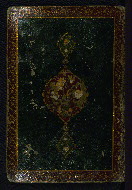
- Title: Binding
- Form: Binding
- Label: This lacquer binding with central ovals and pendants decorated with flowers dates to the thirteenth century AH / nineteenth CE.
fol. 2b:
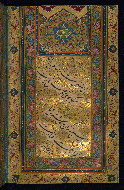
- Title: Illuminated calligraphy page
- Form: Calligraphy page
- Label: This illuminated calligraphy page is written in nastaʿlīq script and signed by ʿImād al-Ḥasanī.
fol. 3a:
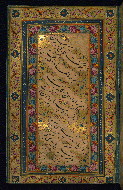
- Title: Illuminated calligraphy page
- Form: Calligraphy page
- Label: This illuminated calligraphy page is written in nastaʿliq script and signed by [ʿImād] al-Ḥasanī.
fol. 4b:
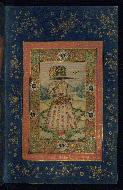
- Title: Portrait of Shāh Ṭahmasp
- Form: Illustration
- Label: This portrait is inscribed Shāh Ṭahmasp (d. 984 AH / 1577 CE), who ruled Safavid Persia from 930 AH / 1524 CE -- 983 AH / 1526 CE. The Safavid painter Shaykh ‘Abbasi, active between 1060 AH / 1650 CE to 1095 AH / 1683-4 CE, executed a number of portraits similar to this one, and he often signed his name in a rectangular panel, as seen in the left foreground of this painting. Someone has erased the artist's signature on the right side of the composition.
fol. 5a:
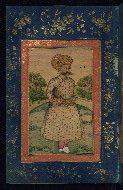
- Title: Portrait of Shāh Sulaymān
- Form: Illustration
- Label: The inscription on this painting indicates that it is a portrait of Shāh Sulaymān. It dates to the late eleventh century AH / seventeenth CE and is attributable to the Safavid painter Shaykh ‘Abbāsī, whose dated works range between 1060 AH / 1650 CE to 1095 AH / 1683-4 CE. Shaykh ‘Abbāsī often signed his name in a rectangular panel. The signature that was originally inscribed on the right side here was erased at some point. The painting is executed in opaque watercolor and gold. The blue, pink, and purple borders with illuminated floral motifs probably date to the early thirteenth century AH / nineteenth CE.
fol. 6b:
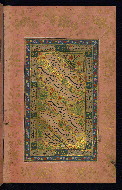
- Title: Illuminated calligraphy page
- Form: Calligraphy page
- Label: This illuminated calligraphy page is written in nastaʿlīq script and signed by Mīr ʿAlī.
fol. 7a:
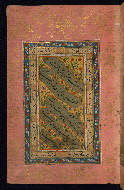
- Title: Illuminated calligraphy page
- Form: Calligraphy page
- Label: This illuminated calligraphy page is written in nastaʿlīq script and is signed by Mīr ʿAlī.
fol. 8b:
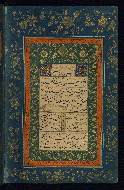
- Title: Illuminated calligraphy page
- Form: Calligraphy page
- Label: This illuminated calligraphy page is written in nastaʿlīq script.
fol. 9a:
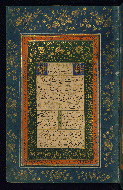
- Title: Illuminated calligraphy page
- Form: Calligraphy page
- Label: This illuminated calligraphy page is written in nastaʿlīq script. The inscription in the diamond-shaped panel reads al-Sulṭān Shāh Fatḥ-ʿAlī Qājār.
fol. W.668.10a:
fol. W.668.10b:
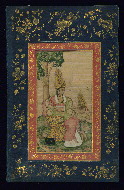
- Title: Mary and Jesus
- Form: Illustration
- Label: This Safavid painting depicts Mary (Maryam) and Jesus (ʿĪsā), as indicated by the inscription. It dates to the late eleventh century AH / seventeenth CE and is attributable to the Safavid painter Shaykh ‘Abbāsī, whose works range between 1060 AH / 1650 CE to 1095 AH / 1683-4 CE and who executed several portraits similar to this one. Shaykh ‘Abbāsī often signed his name in a rectangular panel, as seen in the left foreground here. The signature was erased at some point. The painting is executed in opaque watercolor and gold. The blue, pink, and purple borders with illuminated floral motifs probably date to the early thirteenth century AH / nineteenth CE.
fol. 11a:
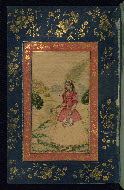
- Title: Mary and Jesus
- Form: Illustration
- Label: This Safavid painting depicts Mary (Maryam) and Jesus (ʿĪsā), as indicated by the inscription. It dates to the late eleventh century AH / seventeenth CE and is attributable to the Safavid painter Shaykh ‘Abbāsī, whose works range between 1060 AH / 1650 CE to 1095 AH / 1683-4 CE and who executed several portraits similar to this one. Shaykh ‘Abbāsī often signed his name in a rectangular panel, as seen in the left foreground here. The signature was erased at some point. The painting is executed in opaque watercolor and gold. The blue, pink, and purple borders with illuminated floral motifs probably date to the early thirteenth century AH / nineteenth CE.
fol. 12b:
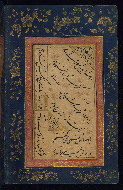
- Title: Illuminated calligraphy page
- Form: Calligraphy page
- Label: This illuminated calligraphy page is written in nastaʿlīq script and dated 1018 AH / 1609-10 CE. It is signed by ʿAlī Riz̤ā-ʾi ʿAbbāsī.
fol. 13a:
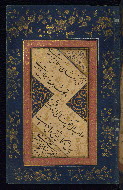
- Title: Illuminated calligraphy page
- Form: Calligraphy page
- Label: This illuminated calligraphy page is written in nastaʿlīq script and signed by ʿAlī Riz̤ā-ʾi ʿAbbāsī.
fol. W.668.14a:
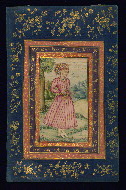
- Title: Portrait of Sām Mīrzā
- Form: Illustration
- Label: This Safavid portrait of the Persian prince Sām Mīrzā dates to the late eleventh century AH / seventeenth CE. The Safavid painter Shaykh ‘Abbāsī, whose dated works range between 1060 AH / 1650 CE and 1095 AH / 1683-4 CE, executed several portraits similar to this one. Shaykh ‘Abbāsī often signed his name in a rectangular panel, as seen in the left foreground here. The signature was erased at some point. The painting is executed in opaque watercolor and gold. The blue, pink, and purple borders with illuminated floral motifs probably date to the early thirteenth century AH / nineteenth CE.
fol. W.668.15a:
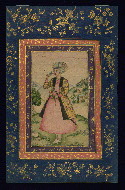
- Title: Portrait of Ismāʿīl Mīrzā
- Form: Illustration
- Label: This portrait is inscribed Ismaʿīl Mīrzā. The figure is depicted dressed in the height of Safavid fashion, wearing a fur-lined robe of floral design and smelling a flower. The latter convention was adapted from European models by Islamic artists as early as the tenth century AH / sixteenth CE. The Safavid painter Shaykh ‘Abbāsī, whose dated works range between 1060 AH / 1650 CE and 1095 AH / 1683-4 CE, executed several portraits similar to this one. Shaykh ‘Abbāsī often signed his name in a rectangular panel, as seen in the left foreground here. The signature was erased at some point. The painting is executed in opaque watercolor and gold. The blue, pink, and purple borders with illuminated floral motifs probably date to the early thirteenth century AH / nineteenth CE.
fol. 18b:
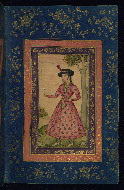
- Title: Woman in a European hat holding a flower
- Form: Illustration
- Label: This portrait depicts a woman in Safavid dress wearing a European hat, holding a flower. It is in the style of the Safavid painter Shaykh ‘Abbāsī, whose dated works range between 1060 AH / 1650 CE to 1095 AH / 1683-4 CE. Shaykh ‘Abbāsī often signed his name in a rectangular panel, as seen in the lower left corner here. Curiously, the signature was erased at some point, although faint traces of the inscription remain. The rectangle seems to have been cut when the work received new borders. The painting is executed in opaque watercolor and gold. The blue, pink, and purple borders with illuminated floral motifs probably date to the early thirteenth century AH / nineteenth CE.
fol. 19a:
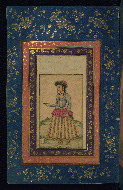
- Title: Female attendant holding a ewer and cup
- Form: Illustration
- Label: This Safavid painting depicts a woman in a fur-trimmed hat offering a cup of wine. It is in the style of the Safavid painter Shaykh ‘Abbāsī, whose dated works range between 1060 AH / 1650 CE and 1095 AH / 1683-4 CE. Shaykh ‘Abbāsī often signed his name in a rectangular panel, as seen at the left here. Although the panel was cut from the codex at some point, the date 1078 AH / 1667 CE is still visible, as is part of the formula this artist frequently used when signing his works. The inscription reads Bā girift chū gardīd. The painting is executed in opaque watercolor and gold. The blue, pink, and purple borders with illuminated floral motifs probably date to the early thirteenth century AH / nineteenth CE.
fol. 20b:
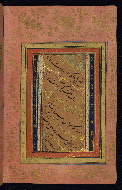
- Title: Illuminated calligraphy page
- Form: Calligraphy page
- Label: This illuminated calligraphy page is written in nastaʿlīq script and signed by ʿAbd al-Rashīd al-Daylamī.
fol. 22b:
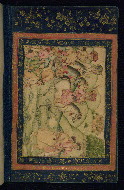
- Title: Safavid official on horseback
- Form: Illustration
- Label: This painting depicts a Safavid official, perhaps a shah or a prince, on horseback with his entourage. It is in the style of the Safavid painter Shaykh ‘Abbāsī, whose dated works range between 1060 AH / 1650 CE and 1095 AH / 1683-4 CE. The painting is executed in opaque watercolor and gold. The blue, pink, and purple borders with illuminated floral motifs probably date to the early thirteenth century AH / nineteenth CE.
fol. W.668.23a:
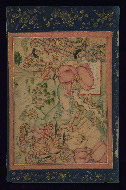
- Title: Court scene
- Form: Illustration
- Label: This Safavid court scene dates to the late eleventh century AH / seventeenth CE. It is in the style of the Safavid painter Shaykh ‘Abbāsī, whose dated works range between 1060 AH / 1650 CE and 1095 AH / 1683-4 CE. The blue and pink borders with illuminated floral motifs probably date to the early thirteenth century AH / nineteenth CE.
fol. W.668.24b:
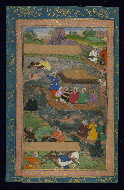
- Title: River scene
- Form: Illustration
- Label: This illustration depicts a river scene from a historical manuscript, possibly Bāburnāmah. Ellen Smart suggests that this folio was originally part of the same codex as W. 596.
fol. W.668.25a:
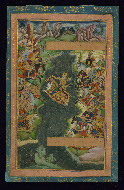
- Title: Battle scene
- Form: Illustration
- Label: This battle scene is possibly from Bāburnāmah. Ellen Smart suggests that the folio was originally part of the same codex as W.596.
fol. 27a:
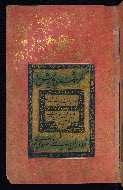
- Title: Illuminated calligraphy page
- Form: Calligraphy page
- Label: This illuminated calligraphy page is written in nastaʿliq script and signed by ʿImād al-Ḥasanī.
fol. W.668.28b:
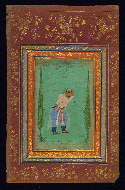
- Title: Portrait of Prince Dāniyāl, brother of Jahāngīr
- Form: Illustration
- Label: This portrait of Prince Dāniyāl, the brother of Jahāngīr, is attributed to the Mughal artist Manūhar by a later and partially erased inscription beside the figure identifying the subject.
fol. W.668.29a:
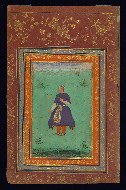
- Title: Portrait of Mandhū Singh
- Form: Illustration
- Label: This portrait of Mandhū Singh is attributed to Manūhar by the inscription in gold. The identity of the subject is inscribed in black nastaʿlīq script.
fol. 30b:
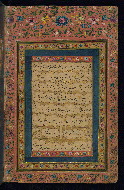
- Title: Illuminated calligraphy page
- Form: Calligraphy page
- Label: This illuminated calligraphy page is written in nastaʿlīq script and signed by ʿImād al-Ḥasanī.
fol. W.668.32b:
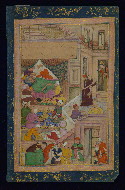
- Title: A prince being treated by a physician
- Form: Illustration
- Label: This painting of an ill prince being treated by a physician is from a Mughal historical manuscript, possibly Bāburnāmah. If so, the subject of this illustration may be Babur, as according to his autobiography he became ill as a young man while engaged in battles. The text has been erased at some point in history. Stylistically, this leaf is attributable to the late tenth century AH / sixteenth CE.
fol. W.668.33a:
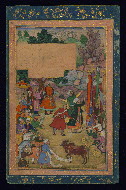
- Title: A festive scene
- Form: Illustration
- Label: This festive scene may be from a historical manuscript, possibly Bāburnāmah. The text has been erased so the exact scene can not be confirmed.
fol. W.668.36a:
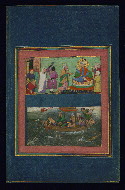
- Title: Scenes from Gulistān by Saʿdī
- Form: Illustration
- Label: These are two illustrations from Gulistān by Saʿdī: a prince holding an audience and the salvation of one brother. These paintings were cut from a Mughal copy of Gulistān attributable to ca. 1018 AH / 1610 CE. The inscription indicates that the artist Dawlat (active ca. 1003 AH / 1595 CE -- 1044 AH / 1635 CE) is responsible for the lower painting. The inscription reads, "the faces done by the slave of the court Dawlat."
fol. W.668.37a:
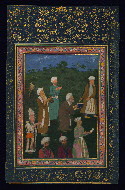
- Title: Saʿdī presents a book of his poems
- Form: Illustration
- Label: This painting (ca. 1023 AH / 1615 CE) by Abu'l Hasan depicts Saʿdī accompanied by a number of officials presenting a book.
fol. 38b:
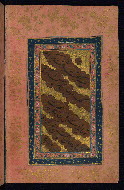
- Title: Illuminated calligraphy page
- Form: Calligraphy page
- Label: This illuminated calligraphy page is written in nastaʿlīq script and signed by ʿAbd al-Rashīd.
fol. 39a:
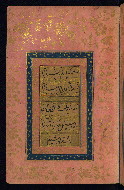
- Title: Illuminated calligraphy page
- Form: Calligraphy page
- Label: This illuminated calligraphy page is written in nastaʿlīq script and signed ʿAbd al-Rashīd.
fol. 40b:
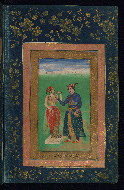
- Title: Jahāngīr giving a cup of wine to a young woman
- Form: Illustration
- Label: The inscription by Abū al-Ḥasan reads kār-i khūb-i nādir al-zamān.
fol. 41a:
fol. 42b:
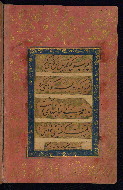
- Title: Illuminated calligraphy page
- Form: Calligraphy page
- Label: This illuminated calligraphy page is written in nastaʿlīq script and signed by ʿImād al-Ḥasanī.
fol. W.668.44b:
fol. W.668.45a:
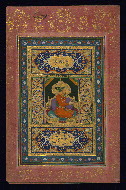
- Title: Shāh Jahān enthroned
- Form: Illustration
- Label: This portarit of Shāh Jahān is signed by Abū al-Ḥasan al-Mashhadī Nādir al-Zamān (lower left panel of the throne).
fol. 46b:
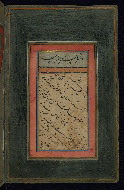
- Title: Illuminated calligraphy page
- Form: Calligraphy page
- Label: This illuminated calligraphy page is written in nastaʿlīq script and signed by ʿImād al-Ḥasanī.
fol. 47a:
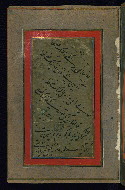
- Title: Illuminated calligraphy page
- Form: Calligraphy page
- Label: This illuminated calligraphy page is written in nastaʿlīq script and signed by ʿImād al-Ḥasanī.
fol. W.668.48b:
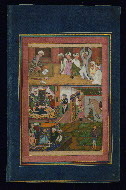
- Title: Three illustrations from a manuscript of Gulistān by Saʿdī
- Form: Illustration
- Label: These three illustrations are from a Mughal manuscript of Gulistān by Saʿdī (ca. 1018 AH / 1610 CE). A religious discussion is depicted in the top register. The middle register tells the story of chapter 1, number 9, in which a rider informs a dying Arab king that a fortress has been conquered and its people have surrendered. The king replies that this is good news, not for him but for his enemies, meaning his heirs. The bottom register depicts a scholarly conversation on a garden terrace.
fol. W.668.49a:
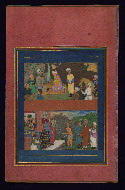
- Title: Two illustrations from a manuscript of Gulistān by Saʿdī
- Form: Illustration
- Label: These two illustrations have been removed from a Mughal manuscript of Gulistān by Saʿdī (ca. 1018 AH / 1610 CE). Both are from the opening chapter, entitled The conduct of kings. The lower register depicts a king who had given a large sum of money to a beggar, who squandered it and then returned for more. At first, the king refused the beggar additional money, but his minister advised him to allot the poor man an allowance in installments so that he would not squander it. This anecdote is meant to illustrate that one should not render someone hopeful by an act of unbounded kindness and then dash his or her hopes. The upper register depicts a prince visiting holy men in the wilderness.
fol. 50b:
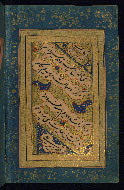
- Title: Illuminated calligraphy page
- Form: Calligraphy page
- Label: This illuminated calligraphy page is written in nastaʿlīq script and signed by Mīr ʿAlī.
fol. 51a:
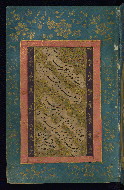
- Title: Illuminated calligraphy page
- Form: Calligraphy page
- Label: This illuminated calligraphy page is written in nastaʿlīq script and signed by ʿImād al-Ḥasanī.
fol. W.668.52b:
fol. W.668.53a:
fol. 55a:
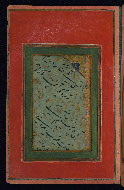
- Title: Illuminated calligraphy page
- Form: Calligraphy page
- Label: This illuminated calligraphy page is written in nastaʿlīq script and signed by ʿAbd al-Rashīd.
fol. 56b:
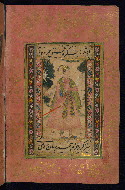
- Title: Portrait of a young prince
- Form: Illustration
- Label: This portrait of a young prince is dated Jumadá I 1062 AH / 1652 CE and is framed by Persian verses.
fol. 57a:
fol. 58b:
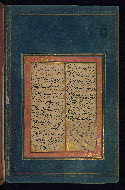
- Title: Illuminated calligraphy page
- Form: Calligraphy page
- Label: This illuminated calligraphy page is written in shikastah script and dated Dhū al-Qaʿdah 1184 AH / 1771 CE.
fol. 60b:
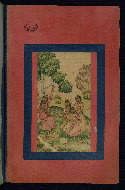
- Title: A young Indian woman entertained by female musicians
- Form: Illustration
- Label: This painting dates to the mid to late eleventh century AH / seventeenth CE and is attributable to the Safavid painter Shaykh ‘Abbāsī, whose works range between 1060 AH / 1650 CE to 1095 AH / 1683-4 CE. Shaykh ‘Abbāsī often signed his name in a rectangular panel, as seen in the left foreground here. The signature was erased at some point. The painting is executed in opaque watercolor and gold.
fol. W.668.61a:
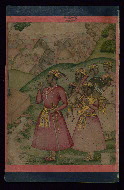
- Title: A Mughal nobleman with his attendants at a camp
- Form: Illustration
- Label: This painting depicts a Mughal official. It is in the style of the Safavid painter Shaykh ‘Abbāsī, whose dated works range between 1060 AH / 1650 CE and 1095 AH / 1683-4 CE. The painting is executed in opaque watercolor and gold. The pink and blue borders probably date to the late thirteenth century AH / nineteenth CE.
fol. W.668.64b:
fol. W.668.65a:
fol. 66b:
fol. 68b:
fol. 69a:
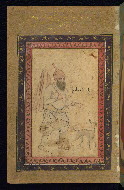
- Title: A dervish leading a dog
- Form: Illustration
- Label: This color-wash drawing (ca. 1018 AH / 1610 CE) bears the signature of Rāqimuhu Ṣādiqī in pseudo-Kufic script. The Safavid artist Ṣādiqī (eleventh century AH / seventeenth CE) signed other works in the same manner.
fol. 74b:
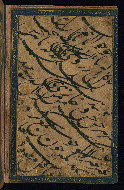
- Title: Exercises (pen trials) in nastaʿlīq script
- Form: Calligraphy page
- Label: This page of exercises (pen trials) in nastaʿlīq script is signed by ʿImād al-Ḥasanī.
fol. 75a:
The binding is not original.
Probably thirteenth century AH / nineteenth CE; lacquer boards (no flap); central ovals and pendants decorated with flowers
Seal impression: ʿAbduh Khudādād, 1189 AH / 1775 CE (fol. 58a)
Seal impression: Farhād, 1234 AH / 1800 CE (on a number of folios)
Inscriptions in Russian and Persian, 1237 AH / 1821 CE (fol. 71b)
Seal impression: Muḥammad al-Ḥasanī (fol. 28a)
Seal impression: Fatḥ ʿAlī (fol. 82b)
Walters Art Museum, 1931, by Henry Walters bequest
Farhad, Massumeh. "Safavid Single-Page Paintings 1629-1666." (PhD diss., Harvard University, 1987), 204-216.
Beach, Milo Cleveland. "The Mughal Painter Abu'l Hasan and some English Sources for his Style." Journal of the Walters Art Gallery 38 (1980): 6-33.
Ettinghausen, Richard. Paintings of the Sultans and Emperors of India in American Collections. (New Delhi: Lalit Kalā Akademi, 1961), 37, pl. 11.
Hubbard, I. "ʿAlī Riẓā-i ʿAbbāsī, Calligrapher and Painter." Ars Islamica 4 (1937): 282-91.
Smart, Ellen S. "Yet Another Illustrated Akbari Baburnama Manuscript." In Facets of Indian Art. Robert Skelton. (London: Victoria and Albert Museum, 1986), 105-115.
Beach, Milo, Eberhard Fischer, and B. N. Goswamy. Masters of Indian Painting 1100-1650. Artibus Asiae Supplementum 48, vol. 1., 2011.
Bailey, Gauvin. "Supplement: The Sins of Sadiqi’s Old Age." In Persian Painting from the Mongols to the Qajars. Robert Hillenbrand. (London, I. B. Tauris, 2000), 264-265.
See also "Abu’l-Ḥasan Nāder-al-Zamān," "ʿAlī-Reżā Abbāsī," "ʿEmād Ḥasanī, Mīr, ʿEmad-al-Molk," "Šayk Abbāsī," and "ʿAbd-al-Rašīd Daylamī." Encyclopaedia Iranica, s.v.
Skelton, Robert. "Ghiyath al-Din 'Ali-yi Naqshband and an Episode in the Life of Sadiqi Beg." In Persian Painting from the Mongols to the Qajars. Robert Hillenbrand. (London: I. B. Tauris, 2000), 249-263.
Gahlin, Sven. The Courts of India: Indian Miniatures from the Collection of the Fondation Custodia, Paris. Paris: Fondation Custodia; Zwolle, Netherlands: Waanders Publishers, 1991.
Principal cataloger: Gacek, Adam
Catalogers: Landau, Amy; Smith, Sita
Copy editor: Bockrath, Diane
Conservators: Jewell, Stephanie; Quandt, Abigail
Contributors: Barrera, Christina; Emery, Doug; Herbert, Lynley; Noel, William; Simpson, Shreve; Tabritha, Ariel; Toth, Michael B.; Valle, Chiara
The Walters Art Museum
Licensed for use under Creative Commons Attribution-NonCommercial-ShareAlike 3.0 Unported Access Rights, http://creativecommons.org/licenses/by-nc-sa/3.0/legalcode. It is requested that copies of any published articles based on the information in this data set be sent to the curator of manuscripts, The Walters Art Museum, 600 North Charles Street, Baltimore MD 21201.
